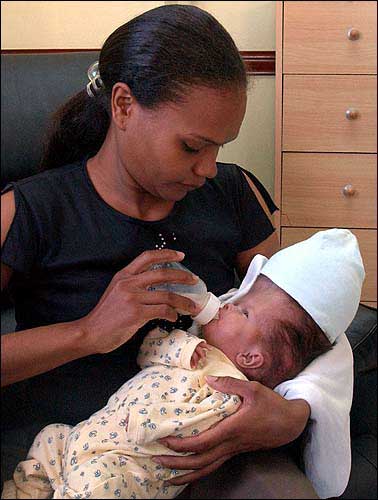Baby dies after second head removed
Dominican Republic ? An infant girl born with a second head bled to death Saturday after complex surgery to remove her partially formed twin, her parents and doctors said.
A medical team completed the 11-hour operation Friday night and said 8-week-old Rebeca Martinez died seven hours later. Doctors had warned after the surgery that the girl would be at great risk of infection or hemorrhaging.
“We knew this was a very risky surgery, and now we accept what God has decided,” Rebeca’s father, 29-year-old Franklin Martinez, said at a news conference with his wife. “Rebeca is no longer with us physically, but no one will forget her.”
The family buried Rebeca in a private funeral Saturday evening.
The girl lost a lot of blood in the operation, which apparently caused her to suffer a heart attack, said Dr. Jorge Lazareff, the lead surgeon. Friends and family had donated almost 4 gallons of blood for surgeons to use during Rebeca’s operation.
“This was not a failure or an error,” Lazareff said. “When we left here last night at midnight the girl was in stable condition. At some point in the middle of the night, she started to bleed.”
Rebeca was born Dec. 10 with the undeveloped head of her twin, an extremely rare condition known as craniopagus parasiticus.
All the other infants documented to have had the condition died before birth, making Rebeca’s surgery the first known operation of its kind.
“She was too little to withstand the surgery,” said her mother, 26-year-old Maria Gisela Hiciano, sobbing softly. She said doctors told her Rebeca died about 6 a.m.
Martinez said doctors told them about 3 a.m. that Rebeca suffered a minor heart attack because of the bleeding, but they believed they could stabilize her. Rebeca then had more heart attacks at 5 a.m. and died shortly after 6 a.m., he said.

Rebeca Martinez
Doctors said Rebeca had several blood transfusions, which complicated normal clotting. They also said her heart was accustomed to beating faster to pump out more blood for the second head.
“In that case, you can’t do anything. This is the worst complication that can happen in this kind of surgery,” said Dr. Benjamin Rivera, one of Rebeca’s surgeons.
Doctors will learn more in the coming months as they review Rebeca’s operation, said Lazareff, who is director of pediatric neurosurgery at the University of California at Los Angeles’ Mattel Children’s Hospital. In 2002, he led a team that successfully separated conjoined Guatemalan twin girls.
During Friday’s surgery, 18 surgeons, nurses and doctors worked in rotations to cut off the undeveloped tissue, clip the veins and arteries, and close the skull using a bone and skin graft from the second head.
“We feel like we’ve lost a family member,” said Dr. Santiago Hazim, medical director of Santo Domingo’s Center for Orthopedic Specialties, where the surgery was performed.
The Center for Orthopedic Specialties is among the country’s top hospitals, and the medical team from UCLA visited two weeks before the surgery to make sure they had everything they needed.
CURE International, a Lemoyne, Penn.-based charity, paid $100,000 for the surgery. The group funds medical care to disabled children in developing countries.
“We always saw Rebeca without the extra part of her body,” her father said after her death.
Rebeca was Hiciano’s third child — along with a 4-year-old boy and 1-year-old girl.
“We aren’t going to have any more children,” she said. “Not because of what happened to Rebeca, but for economic reasons.”
Hiciano, a supermarket cashier, and her husband, who is a tailor, together make about $200 a month.

